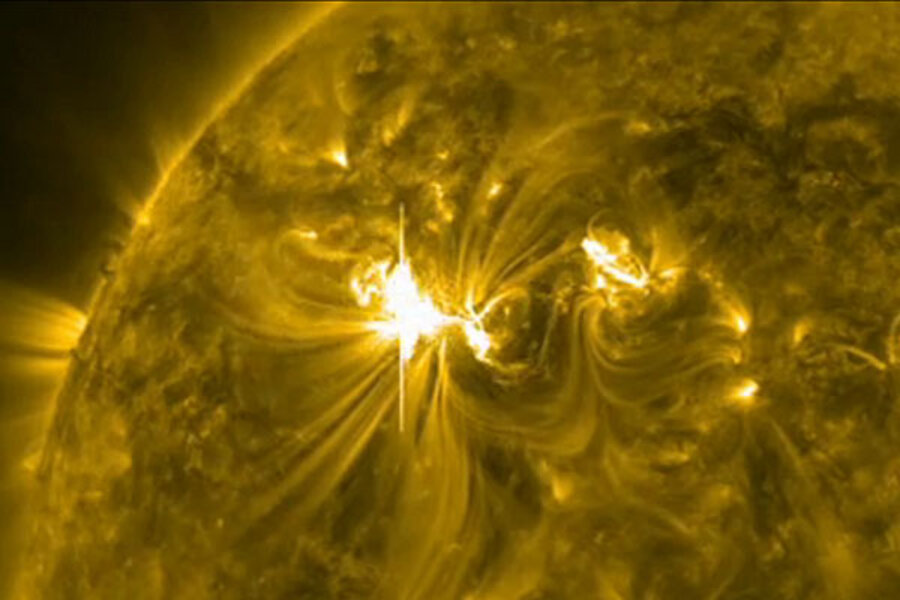Will the solar storm disrupt power grids?
Loading...
A massive solar flare that erupted from the sun late Tuesday (March 6) is unleashing one of the most powerful solar storms in more than five years, a solar tempest that may potentially interfere with satellites in orbit and power grids when it reaches Earth.
"Space weather has gotten very interesting over the last 24 hours," Joseph Kunches, a space weather scientist at the National Oceanic and Atmospheric Administration (NOAA), told reporters today (March 7). "This was quite the Super Tuesday — you bet."
Several NASA spacecraft caught videos of the solar flare as it hurled a wave of solar plasma and charged particles, called a coronal mass ejection (CME), into space. The CME is not expected to hit Earth directly, but the cloud of charged particles could deliver a glancing blow to the planet.
Early predictions estimate that the CME will reach Earth tomorrow (March 8) at 7 a.m. EST (1200 GMT), with the effects likely lasting for 24 hours, and possibly lingering into Friday, Kunches said.
The solar eruptions occurred late Tuesday night when the sun let loose two huge X-class solar flares that ranked among the strongest type of sun storms. The biggest of those flares registered as an X5.4-class solar storm on the space weather scale, making it the strongest sun eruption so far this year. [See photos & videos of the solar storm]
Typically, CMEs contain 10 billion tons of solar plasma and material, and the CME triggered by last night's X5.4-class flare is the one that could disrupt satellite operations, Kunches said.
"When the shock arrives, the expectation is for heightened geomagnetic storm activity and the potential for heightened solar radiation," Kunches said.
This heightened geomagnetic activity and increase in solar radiation could impact satellites in space and power grids on the ground. Some high-precision GPS users could also be affected, he said.
"There is the potential for induced currents in power grids," Kunches said. "Power grid operators have all been alerted. It could start to cause some unwanted induced currents."
Airplanes that fly over the polar caps could also experience communications issues during this time, and some commercial airliners have already taken precautionary actions, Kunches said. Powerful solar storms can also be hazardous to astronauts in space, and NOAA is working close with NASA's Johnson Space Center to determine if the six residents of the International Space Station need to take shelter in more protected areas of the orbiting laboratory, he added.
The flurry of recent space weather events could also supercharge aurora displays (also known as the northern and southern lights) for skywatchers at high latitudes.
"Auroras are probably the treat that we get when the sun erupts," Kunches said.
Over the next couple days, Kunches estimates that brightened auroras could potentially be seen as far south as the southern Great Lakes region, provided the skies are clear.
Yesterday's solar flares erupted from the giant active sunspot AR1429, which spewed an earlier X1.1-class flare on Sunday (March 4). The CME from that outburst mostly missed Earth, passing by last night at around 11 p.m. EST (0400 GMT March 7), according to the Space Weather Prediction Center, which is jointly managed by NOAA and the National Weather Service.
This means that the planet is already experiencing heightened geomagnetic and radiation effects in advance of the next oncoming CME.
"We've got a whole series of things going off, and they take different times to arrive, so they're all piling on top of each other," Harlan Spence, an astrophysicist at the University of New Hampshire, told SPACE.com. "It complicates the forecasting and predicting because there are always inherent uncertainties with any single event. Now, with multiple events piling on top of one another, that uncertainty grows."
Scientists are closely monitoring the situation, particularly because the AR1429 sunspot region remains potent.
"We think there will be more coming," Kunches said. "The potential for more activity still looms."
As the sun rotates, the AR1429 region is shifting closer to the central meridian of the solar disk. From there, flares and associated CMEs may pack more a punch because they are more directly pointed at Earth.
"The sun is waking up at a time in the month when Earth is coming into harm's way," Spence said. "Think of these CMEs somewhat like a bullet that is shot from the sun in more or less a straight line. When the sunspot is right in the middle of the sun, something launched from there is more or less directed right at Earth. It's kind of like how getting sideswiped by a car is different than a head-on collision. Even still, being sideswiped by a big CME can be quite dramatic."
Spence estimates that sunspot region AR1429 will rotate past the central meridian in about a week.
The sun's activity ebbs and flows on an 11-year cycle. The sun is in the midst of Solar Cycle 24, and activity is expected to ramp up toward the solar maximum in 2013.
If you snap an amazing photo of the northern lights sparked by these sun storms and would like to share it for a possible story or image gallery, please contact SPACE.com managing editor Tariq Malik at tmalik@space.com.
You can follow SPACE.com staff writer Denise Chow on Twitter @denisechow. Follow SPACE.com for the latest in space science and exploration news on Twitter @Spacedotcom and on Facebook.





